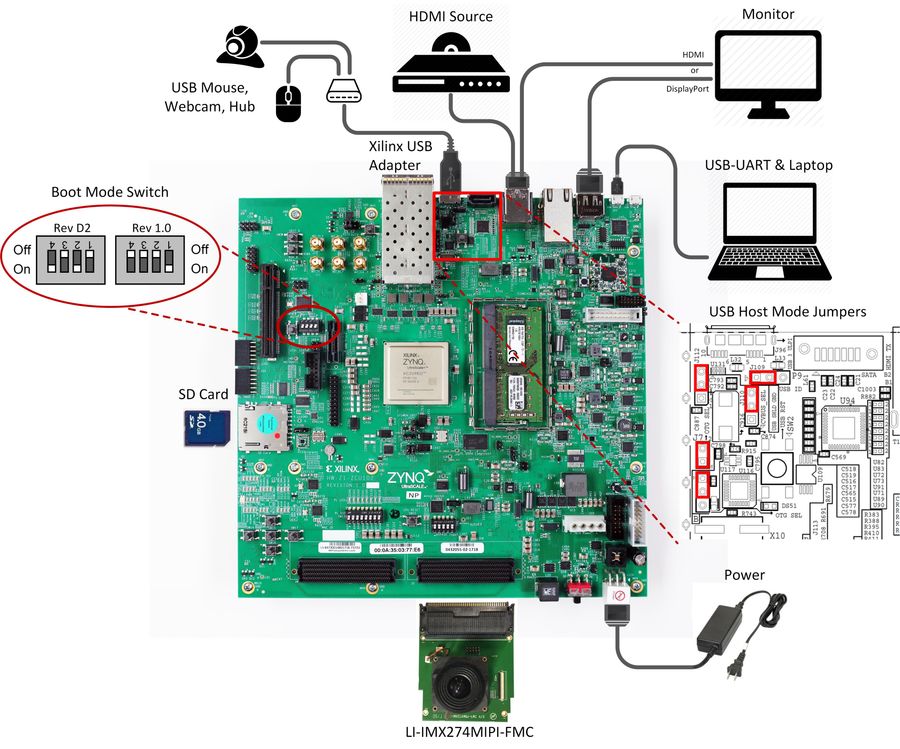...
Build and Run Flow
To run the pre-built SD card image for design module 10, follow the instructions here.
The following tutorials assume that the
$TRD_HOME environment variable has been set as below.| Code Block | ||||
|---|---|---|---|---|
| ||||
% export TRD_HOME=</path/to/downloaded/zip-file>/rdf0421-zcu102-base-trd-2019-1 |
For the individual tutorials, follow the links below:
| Anchor | ||||
|---|---|---|---|---|
|
- DM1 Tutorial – APU SMP Linux
- DM2 Tutorial – RPU0 FreeRTOS Application
- DM3 Tutorial – RPU1 Bare-metal Application
- DM4 Tutorial – APU/RPU1 Inter Process Communication
- DM5 Tutorial – APU Qt Application
- DM6 Tutorial – PL Video Capture
- DM7 Tutorial – OpenCV-based Image Processing
- DM8 Tutorial – PL-accelerated Image Processing
- DM9 Tutorial – Two Image Processing Functions
- DM10 Tutorial – Full-fledged Base TRD
Other Information
Known Issues
- There is a GLIB memory leak when switching modes in the GUI if an accelerator is part of the pipeline and set to HW mode.
- Frequency: Common
- Workaround: Already implemented in the 2018.3 release (by setting environment variable
G_SLICE=always-mallocbefore executing video_qt2 application)
- Application crashes after popping out "Failed to allocate required memory" dialog box if you connect a HDMI-rx input-source which is in sleep mode .
- Frequency: Intermittent
- Workaround: Power-cycle your HDMI-rx input (for e.g. Nvidia Shield TV) to make it out-of-sleep. Kill the BaseTRD application from the linux prompt and re-run again.
Limitations
- SDSoC accelerator code runs very slow in pure software implementation when Debug configuration is used. For faster execution, set project build configuration to Release which sets SDSoC compiler to optimize most (-O3).
- Accelerator frame rate drops if HDMI Tx 4K60 is selected. The Filter2d frame rate maxes out at 4K 30 fps and the optical flow frame rate maxes out at 4K 35 fps.
- The application only supports the following display resolutions: 3840x2160, 1920x1080 and 1280x720.
- The application does not support audio.
- USB webcams:
- Need to support the YUYV pixel format.
- Most webcams don't support resolutions > 1080p using uncompressed video. Make sure you start the GUI in 1080p or 720p mode using the -r switch if you want to use your webcam as video source.
- For USB2 webcams, it is expected to see increased latency and low frame rate.
- Do not connect a DisplayPort cable and HDMI Tx at the same time.
- Make sure the DisplayPort or HDMI Tx cable is plugged in when you power on the board.
- DP-to-HDMI adapters are not supported, see AR 67462
- HDMI Rx:
- Does not support YUV 4:2:0 input.
- Does not support HDCP encrypted input.
- Does not support hotplug or dynamic resolution changes while the application is running.
- Leopard LI-IMX274MIPI-FMC:
- The Leopard IMX274 MIPI FMC is only supported on rev 1.0 boards and will not work on rev D2 boards.
- SDSoC does not support “Estimate Performance” for the xfopenCV library and in general for all the C++ templates (the part of Performance Estimation flow not yet supported is the estimate of software performance for function templates). Once the HLS estimate of HW resources pops up, the Ethernet P2P communication process between the SDSoC GUI and the board stalls forever and no error message is displayed.
- Harmless warning message on the serial console for DM1-9 designs : "Failed to open rpmsg file /dev/rpmsg0.: No such file or directory"
- Sometimes you might get a blank screen on HDMI monitors when you power-on zcu102. As a workaround, try power-cycling your HDMI monitor
- CPU idle and frequency scaling have been disabled in the kernel bootargs according to SDSoC guidelines (see UG1146, pg 46) and to enable debug with xsdb (see AR69143).
Support
To obtain technical support for this reference design, go to the:
- Xilinx Answers Database to locate answers to known issues
- Xilinx Community Forums to ask questions or discuss technical details and issues. Please make sure to browse the existing topics first before filing a new topic. If you do file a new topic, make sure it is filed in the sub-forum that best describes your issue or question e.g. Embedded Linux for any Linux related questions. Please include "ZCU102 Base TRD" and the release version in the topic name along with a brief summary of the issue.
